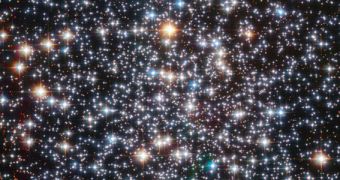This spectacular image of the stellar cluster M4 helped astronomers discover what is perhaps the oldest extrasolar planet in the Universe. The object, named PSR B1620-26 b, is currently estimated to be around 13 billion years old.
In addition to being three times older than our entire solar system, the planet is also ancient by cosmic standards, since the Big Bang is believed to have occurred just 13.75 billion years ago. This means that the exoplanet formed when the firmament was just 750 million years old.
What's weird about it is that it orbits a binary system made up of a white dwarf – the helium-burning core of a former Sun-sized star – and a neutron star. The latter most likely formed following a supernova blast, from a massive progenitor.
M4 lies relatively close to Earth, at a distance of roughly 7200 light-years. It contains tens of thousands of very old stars, which are strongly bound together by gravity. This has made it a wonderful target for astronomers for many years, as evidenced by this image from the NASA/ESA Hubble Space Telescope.

 14 DAY TRIAL //
14 DAY TRIAL //